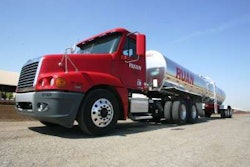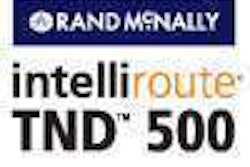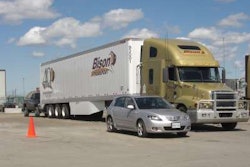Even the best drivers can be caught offguard. Electronic stability control and roll stability control systems can help them recover.
Certain dangerous driving situations unfold quickly, and drivers may need all the help they can get to stabilize the vehicle. That is the goal of roll stability control (RSC) and full electronic stability control (ESC) systems.
These systems are an outgrowth of ABS and its close cousin, traction control. Roll stability control is designed to determine when a vehicle is approaching the rollover limit and reduce throttle, apply the engine brake or, finally, apply the service brakes in a uniform manner, slowing the vehicle enough to prevent a rollover. Full stability control adds the ability to apply brakes selectively – thus enabling it to straighten out a tractor that’s starting to jacknife – and may make more powerful emergency braking practical because of its capabilities in keeping the vehicle stable.
The systems build on ABS, adding standard brake-apply solenoids, more sensors, processing capacity and sophisticated software. The latter contains the algorithms necessary to produce the right, complex reaction to a given panic-driving situation.
Options and retrofits
Both Meritor WABCO and Bendix offer both roll stability and full electronic stability control on new tractors from all the major OEMs. Those two companies, as well as Haldex, offer trailer roll stability control. Haldex’s trailer system (“TRS,” for Trailer Roll Stability Control) can activate the trailer brakes selectively if sensing a rollover is near, or apply all four if slowing the vehicle quickly is essential. TRS offers an optional premium power cord extension that activates the trailer brake lights when the system is applying the trailer brakes; it also records all unstable braking events for later review with optional software.
Bendix’s trailer system is available in the aftermarket for retrofit because of “the perpetual existence of trailers,” says Rick Conklin, project manager for Bendix ESP, the company’s name for its ESC system. The ESP and roll stability control systems apply all four trailer brakes as they apply the tractor brakes through normal pneumatic connection, he says.
Mark Melletat, Meritor WABCO’s senior manager of marketing and customer service, says his company’s ESC and RSC perform the same function. This means you don’t need to have trailer roll stability control for the system to work on a rig; the separate trailer systems enhance the performance of tractor systems. In addition, Meritor WABCO’s SmartTrac suite of antilock braking, automatic traction control and stability control systems is available as a factory-installation option.
ESP adds a yaw rate sensor and a steer angle sensor to the lateral acceleration sensor needed for roll stability. Conklin says the system measures the angle of the vehicle’s turn and compares that to the driver’s input. If they don’t match, it applies brakes selectively – for example, applying only the right front drive axle brakes – to bring the vehicle into line.
The hot setup is full stability control, says Fred Andersky, Bendix Heavy Vehicle Systems’ director of marketing for controls, who cites a National Tank Truck Carriers’ instability study conducted by Batelle Institute that found that 53 percent of rollovers occur on straight roads. “The driver slips off the edge of the pavement, and then overcompensates with corrective steering,” Andersky says. “You often end up with loss of control and a truck on its side.”
Bendix offers only full ESP on straight trucks, Conklin says, but roll stability control is not workable there because a straight truck has different, rapidly unfolding dynamics that require a more sophisticated system.
Installing stability control
Exactly what is added or changed when stability control is installed? In Bendix’s case, in addition to the sensors already mentioned, a different, more powerful electronic control unit (ECU) is installed with the Bendix tractor systems to control both the tractor ABS and the roll stability control or electronic stability control system, rather than adding a separate ECU, Conklin says. The other systems all have separate processors.
Melletat says that in addition to the inputs from the ABS wheel sensors and data communication, a stability control system can include a lateral accelerometer, yaw rate sensor, brake pressure demand sensor, and electronic solenoid valves for active brake control. “RSC does not apply the front axle brakes, which makes the system less expensive and simpler without a significant reduction in performance,” Melletat says. “This way, it can calculate the level of braking applied by the driver by measuring front axle wheel slip.” Bendix RSC also controls only tandem axle brakes.
The Haldex trailer system utilizes its own ECU, wheel speed sensors, five pressure transducers and an integral brake apply function to monitor and assist in controlling the trailer dynamics and speed, with or without driver intervention, says Duane Stocksdale, product manager of braking controls.
Calculating cost
For any fleet manager who specifies vehicles, one of the largest issues relating to these systems is cost justification. “A few fleets have seen insurance discounts, though the more common pattern is for the insurance risk profile to change and the rates after that,” Andersky says. For self-insured fleets, there is often a positive impact on the bottom line; Andersky says Bendix had one customer running 100 rigs that saw a rollover rate of about three per year drop to one in three years.
Both Haldex and Meritor WABCO mentioned a study conducted by the Federal Motor Carrier Safety Administration and the American Transportation Research Institute that showed that, over a five-year period, the systems reduced overall costs:
·Lane departure warning systems: For each $1 spent, the return on investment (ROI) ranges from $1.37 to $6.55, with a payback period of nine to 37 months;
·Roll stability control systems: For each $1 spent, ROI ranges from $1.66 to $9.36, with a payback period of six to 30 months; and
·Forward collision warning systems: For each $1 spent, ROI ranges from $1.33 to $7.22, with a payback period of eight to 37 months.
With results like these, perhaps your fleet should consider adopting such systems.












